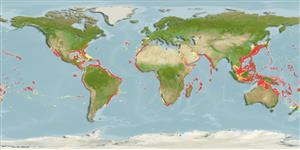Common names from other countries
>
Scombriformes (Mackerels) >
Bramidae (Pomfrets)
Etymology: Taractes: Greek, taraktes = confusion; for the pletora of names that have been applied to this fish (Ref. 45335).
More on authors: Jordan & Evermann.
Environment: milieu / climate zone / depth range / distribution range
Οικολογία
Θαλασσινό(ά) βενθοπελαγικό; ωκεανόδρομο(ς) (Ref. 51243); εύρος βάθους 0 - 600 m (Ref. 82736). Tropical
Pacific and Atlantic: widely distributed in tropical waters (Ref. 559). Eastern Central Pacific: Costa Rica to Peru. Eastern Atlantic: off west Africa. Western Atlantic: Gulf of Mexico, Trinidad. Not known from the Indian Ocean (Ref. 4936). Recently reported in Aden Gulf, Arabian Sea (Ref. 85285). Highly migratory species.
Μέγεθος / Βάρος / Age
Maturity: Lm ? range ? - ? cm
Max length : 89.0 cm TL αρσενικό/απροσδιόριστο; (Ref. 97146); common length : 30.0 cm TL αρσενικό/απροσδιόριστο; (Ref. 55763)
Ραχιαίες άκανθες (συνολικά) : 0; Μαλακές ραχιαίες ακτίνες (συνολικά) : 30 - 32; Εδρικές άκανθες: 0; Μαλακές εδρικές ακτίνες: 21 - 23. Caudal peduncle with a strong keel formed of enlarged and fused scales. Scaleless areas above and behind the eyes. Lateral line in adults obsolete. Fins of juveniles very long. Attains 70 cm SL.
Adults occur from shallow water to about 600 m depth offshore (Ref. 82736). Often solitary (Ref. 82736).
Life cycle and mating behavior
Maturities | Αναπαραγωγή | Spawnings | Egg(s) | Fecundities | Προνύμφες
Gomes, J., 1990. Bramidae. p. 758-764. In J.C. Quero, J.C. Hureau, C. Karrer, A. Post and L. Saldanha (eds.) Check-list of the fishes of the eastern tropical Atlantic (CLOFETA). JNCT, Lisbon; SEI, Paris; and UNESCO, Paris. Vol. 2. (Ref. 4936)
IUCN Red List Status (Ref. 130435)
CITES (Ref. 128078)
Not Evaluated
Threat to humans
Harmless
Human uses
αλιεία: Εμπορικό(ά)
Εργαλεία
Special reports
Download XML
Διαδικτυακές πηγές
Estimates based on models
Preferred temperature (Ref.
115969): 12.7 - 26.1, mean 18.6 (based on 1171 cells).
Phylogenetic diversity index (Ref.
82804): PD
50 = 0.7500 [Uniqueness, from 0.5 = low to 2.0 = high].
Bayesian length-weight: a=0.01122 (0.00514 - 0.02450), b=3.04 (2.87 - 3.21), in cm Total Length, based on all LWR estimates for this body shape (Ref.
93245).
Τροφικό Επίπεδο (Ref.
69278): 4.3 ±0.6 se; based on size and trophs of closest relatives
Ελαστικότητα (Ref.
120179): Υψηλό, ελάχιστος χρόνος για διπλασιασμό πληθυσμού < 15 μήνες (Fec > 10,000).
Fishing Vulnerability (Ref.
59153): High vulnerability (56 of 100).
